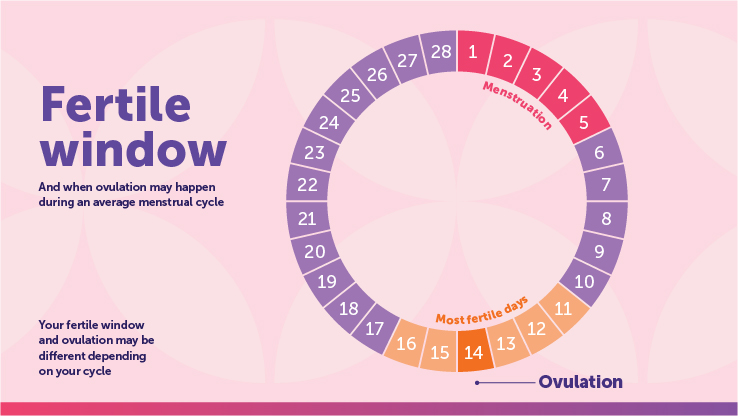When Are You Least Likely to Get Pregnant? A Comprehensive Guide

Key points
- Basal Body Temperature (BBT): Your BBT is your body's lowest resting temperature. It rises slightly (about 0.5°F or 0.3°C) after ovulation occurs and stays elevated until your next period. By tracking it daily, you can confirm when ovulation has passed.
- Cervical Mucus Monitoring: Your vaginal discharge changes throughout your cycle. Around ovulation, it becomes clear, slippery, and stretchy, like raw egg whites. This indicates peak fertility. During infertile times, it is typically sticky, cloudy, or absent.
- Sympto-Thermal Method: This method combines BBT charting with cervical mucus monitoring for greater accuracy. With correct and consistent use, studies show its effectiveness can be as high as 99.6%. However, typical use effectiveness is lower.
Understanding your menstrual cycle is essential whether you're trying to conceive or prevent pregnancy. While no time is 100% risk-free without a reliable form of contraception, there are specific phases in your cycle when you are significantly less likely to get pregnant. This guide synthesizes expert advice and clinical data to provide a comprehensive look at your fertility.
Understanding Your Menstrual Cycle and Fertility
The menstrual cycle is more than just your period; it's a complex hormonal process that prepares your body for a potential pregnancy each month. A typical cycle lasts about 28 days, but it's normal for it to range from 23 to 35 days. It's divided into four main phases:
- Menstrual Phase (Your Period): This is day 1 of your cycle, when the uterus sheds its lining.
- Follicular Phase: This phase starts on day 1 and lasts until ovulation. The brain signals the ovaries to prepare an egg for release.
- Ovulation: The release of a mature egg from an ovary. This is the peak of fertility and usually happens around day 14 in a 28-day cycle.
- Luteal Phase: This is the time after ovulation and before your next period. The body prepares the uterine lining for a fertilized egg. If pregnancy doesn't occur, the cycle restarts.
Your "fertile window" is the period when you are most likely to conceive. It includes the five days leading up to ovulation and the day of ovulation itself. This is because sperm can survive in the female reproductive tract for up to five days, and an egg is viable for about 12-24 hours after being released.

Pinpointing the Times You Are Least Likely to Conceive
Based on the phases of the menstrual cycle, there are three distinct times when your chances of getting pregnant are at their lowest.
During Your Period (Menstrual Phase, Days 1-7)
This is generally considered the "safest" time of the month. The uterine lining is being shed, which makes it a hostile environment for a fertilized egg to implant. For most people, ovulation is still many days away.
However, the risk is not zero. Dr. Gina Frugoni, an OB/GYN at UC San Diego Health, confirms that while it's "not very likely, but still possible" to get pregnant during your period. This is especially true for individuals with shorter menstrual cycles (e.g., 21-24 days), as ovulation can occur much closer to the end of their period. According to research cited by Everlywell, the chance of getting pregnant on day 4 of your cycle is about 2%.
Immediately After Your Period (Early Follicular Phase)
In the few days immediately following your period, the likelihood of pregnancy remains low because ovulation has not yet occurred. However, this window of low fertility can be very short. Because sperm can survive for up to five days, having unprotected sex during this time could lead to pregnancy if you ovulate earlier than expected.
The Luteal Phase (After Ovulation, Before Your Next Period)
Once ovulation has occurred and the 12-24 hour window for fertilizing the egg has passed, you enter the luteal phase. During this time, your chances of getting pregnant are extremely low for the remainder of your cycle. If the egg is not fertilized, it disintegrates, and you cannot get pregnant until your next cycle begins. The main challenge with relying on this phase is knowing with certainty that ovulation has already happened.
How to Identify Your Fertile and Infertile Days: Fertility Awareness-Based Methods (FABMs)
To more accurately identify your fertile window, you can use Fertility Awareness-Based Methods (FABMs). These involve tracking your body's natural fertility signals. However, experts like Dr. Kate O'Connell White of Boston University warn, "Using your cycle as a cheap birth control will get you pregnant. It's not something to take lightly."
If you choose to use FABMs, it's best to combine them and use them alongside a barrier method like condoms.
Calendar Rhythm Method
This involves tracking the length of your menstrual cycles for several months to predict your fertile days. The Mayo Clinic notes this is one of the least effective forms of birth control, especially if your cycles are irregular. For a more modern approach, the Standard Days Method is for those with cycles between 26 and 32 days, identifying days 8-19 as fertile.
Symptom-Based Methods (More Reliable)
- Basal Body Temperature (BBT): Your BBT is your body's lowest resting temperature. It rises slightly (about 0.5°F or 0.3°C) after ovulation occurs and stays elevated until your next period. By tracking it daily, you can confirm when ovulation has passed.
- Cervical Mucus Monitoring: Your vaginal discharge changes throughout your cycle. Around ovulation, it becomes clear, slippery, and stretchy, like raw egg whites. This indicates peak fertility. During infertile times, it is typically sticky, cloudy, or absent.
- Sympto-Thermal Method: This method combines BBT charting with cervical mucus monitoring for greater accuracy. With correct and consistent use, studies show its effectiveness can be as high as 99.6%. However, typical use effectiveness is lower.
Important Factors That Influence Your Chances of Pregnancy
Your cycle is not the only thing that matters. Several other factors play a significant role.
The Critical Role of Cycle Regularity
For individuals with irregular periods, predicting the fertile window is extremely difficult. Stress, illness, travel, and hormonal conditions can all disrupt your cycle, making calendar-based methods highly unreliable. If your cycle is irregular, relying on "safe days" is not a recommended method of contraception.
It's Not Just About the Egg: Sperm Viability Matters
A key reason the fertile window is several days long is that sperm can survive in the reproductive tract for up to five days. Male fertility is also crucial. A man's lifestyle and health can impact sperm viability:
- Lifestyle: Smoking and heavy alcohol consumption are linked to lower sperm counts and quality.
- Heat: Exposure to high temperatures from saunas, hot tubs, or even prolonged sitting can impair sperm production.
- Environmental Factors: Exposure to toxins like pesticides and lead can harm sperm.
 Image Source: HealthPartners
Image Source: HealthPartners
Age and Fertility: A Nuanced Look
While it's widely known that fertility declines with age, the idea of a "fertility cliff" at age 35 is a misconception. According to a detailed report by the BBC, the decline is gradual. It begins to speed up in the late 30s, with a more significant drop after age 40. Male fertility also declines with age, typically starting in the late 30s.
The Most Reliable Ways to Prevent Pregnancy
While understanding your cycle is empowering, Fertility Awareness-Based Methods have a higher failure rate with typical use than other forms of contraception. If preventing pregnancy is your priority, consider more reliable methods:
- Long-Acting Reversible Contraceptives (LARCs): IUDs and hormonal implants are over 99% effective.
- Hormonal Methods: Birth control pills, patches, and vaginal rings are up to 93% effective with typical use.
- Barrier Methods: Condoms are 87% effective with typical use and have the added benefit of protecting against STIs.
Consult with a healthcare provider to discuss the best and most effective contraception options for your body and lifestyle.
References
- Mayo Clinic. (2023). Rhythm method for natural family planning.
- Medical News Today. (2021). Safe days for not getting pregnant: Ovulation and more.
- USA Today. (2024). Can you actually get pregnant during your period?
- BBC Future. (2024). Women's fertility is more complicated than you might have heard.
- Utah Department of Health & Human Services. Do you know what your chances of getting pregnant really are?

About the author
Sofia Rossi, MD, is a board-certified obstetrician-gynecologist with over 15 years of experience in high-risk pregnancies and reproductive health. She is a clinical professor at a top New York medical school and an attending physician at a university hospital.